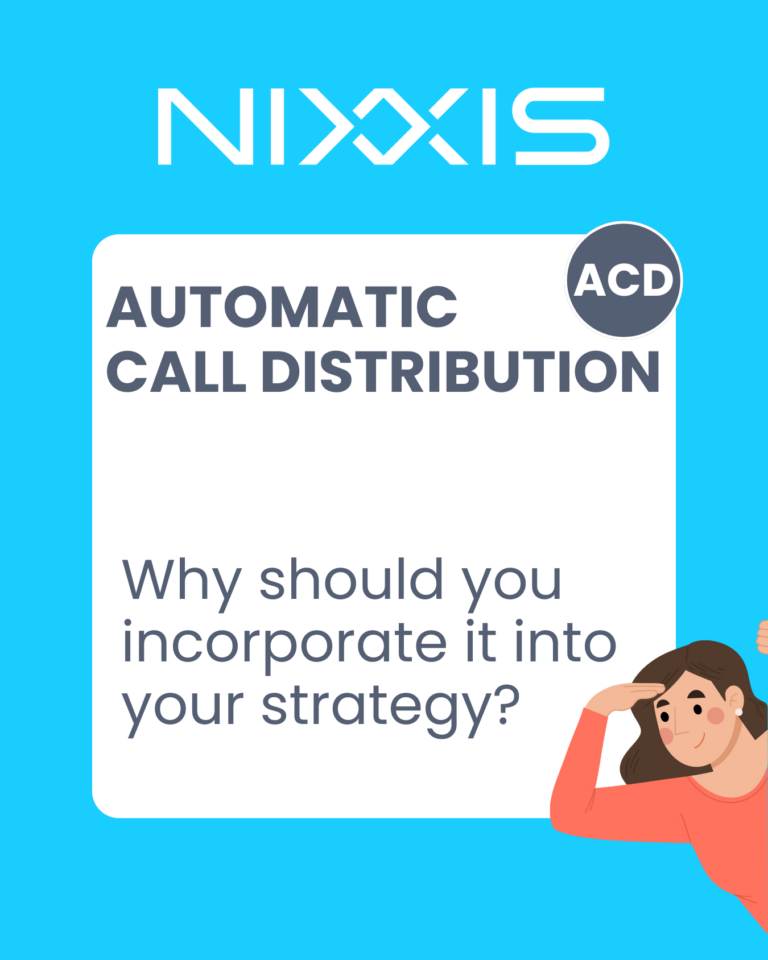In recent years, customer relations have become a key differentiating factor and rightly so! Companies are now placing increased importance on optimizing their customer services. With this in mind, call distribution, the central process for managing inbound calls and their distribution to agents, is of crucial importance in choosing the best tool.
Faced with the multitude of competitors on the market, choosing the right telephony solution is not an easy task, but considering the power of the ACD can be decisive in your selection. To help you make this choice, we offer you seven essential criteria to take into consideration during your evaluation.
Indeed, the chosen telephony solution must meet specific requirements in order to guarantee an optimal customer experience and maximum operational efficiency.
1. Essential features
a) Intelligent call routing based on multiple criteria
At the heart of effective call management is the ability to route calls to the most qualified and directly available agents. It requires an intelligent routing system taking into account various criteria, such as:
- Agent skills: Identifying agents with the skills required to handle each call helps ensure rapid and efficient resolution of customer requests.
- Waiting time: The balanced distribution of calls between agents helps minimize waiting times and improve customer satisfaction.
- Agent availability: The system must identify in real time the agents available to handle incoming calls and thus optimize resource management.
b) Customizing routing rules
Flexibility is a major asset in call distribution. The ability to customize routing rules allows the system to be adapted to the specific needs of each company. By defining certain rules, it is possible to prioritize urgent or most profitable calls, direct customers to dedicated agents, or even implement routing strategies based on language or geographic area.
c) Seamless integration with CRM tools
For an optimal customer experience, the chosen software must integrate seamlessly with CRM and business tools. This integration provides access to relevant customer information upon receipt of the call, including interaction history, current orders and even personal preferences. Agents can thus offer personalized customer service, contextualizing each interaction.
2. Scalability of the tool
a) Managing exponential growth without compromise
The ability to adapt is essential in the Customer Relations sector. The chosen solution must be able to adapt to the growth of the company and manage a larger number of users and fluctuating call volumes. This scalability ensures that the company can meet demand without compromising service quality or operational efficiency.
b) Management of call peaks
Companies often face peaks in activity, particularly during promotional campaigns or holiday periods. A good telephony solution must be able to withstand these traffic peaks, requiring a robust infrastructure capable of handling high call volumes without experiencing slowdowns or failures. It must also make it possible to establish overflow strategies that will limit the number of abandoned calls.
c) Adaptation to load requirements
Every business has its own way of operating and different needs when it comes to call management. You must be able to personalize its settings and functionalities based on call flows, to optimize resource allocation and streamline processes.
3. Ease of use
a) An user-friendly interface
In a successful call center, agent and supervisor productivity is paramount. To ensure this, a fluid and intuitive interface remains the best option to facilitate the use of the interface and reduce training times.
b) Complete user guides
For optimal use of the solution, detailed and accessible user guides are essential. These guides must provide clear and precise instructions on all the functionalities of the solution, illustrated by concrete examples and screenshots. They must also be regularly updated to reflect product developments and new features.
c) Automatic reporting of customer files
Speedy caller ID is the key to a successful customer experience. Upon receiving the call, relevant customer information should be automatically displayed on the agent interface.
4. Reliability and availability
a) Resilience to failures
In a call center, continuity of service is essential to be able to meet the objectives defined by your customers. The solution must be based on a redundant infrastructure, capable of minimizing service interruptions in the event of hardware or software failure. This redundancy makes it possible to automatically switch to backup systems in the event of a failure to ensure continuity of operations.
b) Responsive technical support
Even the most reliable solutions can encounter technical problems. When a breakdown occurs, effective technical support is essential. A team of experts should be available to quickly diagnose issues, provide appropriate solutions, and restore the solution to normal operation as quickly as possible.
c) Regular maintenance system for optimal performance
To maintain tool performance and long-term reliability, a regular maintenance system is required. Regular software updates, bug fixes and optimizations help ensure that the solution remains up-to-date, stable and efficient.
5. Data security
a) Data encryption
Data encryption at all stages of communication is essential. This encryption helps protect sensitive customer information, such as names, addresses, phone numbers and payment data, from unauthorized access and data leaks.
b) Compliance with safety standards for impeccable compliance
Data protection regulations, such as the GDPR (General Data Protection Regulation), impose strict requirements on data security. Compliance with these standards is mandatory and the software must be able to ensure the protection of this data to guarantee customer confidence.
c) Strong authentication
Cyberattacks pose a major threat to data security. Strong authentication mechanisms are necessary to protect access to systems. This may include the use of complex passwords, physical security keys, or multi-factor authentication (MFA), which requires additional verification to confirm the user’s identity.
d) Monitoring and logging user activities
An important feature in data security is the ability to monitor and log user activities, in order to detect suspicious behavior and prevent intrusions. This comes in the form of comprehensive logging and auditing tools to track each user’s actions, data access and system changes. This information allows unauthorized access attempts to be quickly identified and appropriate corrective action taken.
6. Performance Analysis
a) Key performance indicators (KPIs)
To analyze the performance of your teams, the calling solution must be able to provide comprehensive analysis tools to generate detailed reports on key performance indicators (KPIs). These, such as average call handling time (AMT), first call resolution rate (FCA), and customer satisfaction rate (CSAT), provide valuable information on call center efficiency and help identify areas for improvement.
b) Detailed reports
The ability to generate detailed reports is essential for analyzing company performance across multiple data sets. These reports can include information by agent, by team, by call type, by time slot, etc., allowing you to identify strengths and weaknesses and make corrective decisions to optimize processes.
c) Integration with advanced analytics tools
For in-depth analysis, the integration of certain tools may be necessary. These tools allow call data to be cross-referenced with other sources of information, such as CRM data or customer satisfaction surveys, to obtain a complete overview of call center performance and identify trends or opportunities for improvement which might not be obvious with a basic study of the data.
d) Continuous process optimization through actionable data
By analyzing performance data, companies can identify bottlenecks, allocate agents based on their performance and indicate for certain stages of call processing whether training is necessary.
7. Flexibility of communication channels
a) Diversity of channels
Customers today favor varied modes of communication, requiring call distribution solutions to adapt to these expectations by offering multi-channel support. Beyond traditional phone calls, the solution must be able to manage emails, SMS, live chat and messages on social networks. Omnichannel gives customers the freedom to interact with the business through their preferred communication channel.
b) Centralized management of interactions
Taking all these communication channels into account should not impact the user experience. All communication channels must be managed within a single interface, allowing agents to have a complete overview of customer interactions, regardless of the channel used.
8. Conclusion
Choosing the best telephony solution based on its ACD represents a decisive step for companies wishing to optimize the management of call flows within their customer service. Based on the seven key criteria outlined above, businesses are better equipped to identify the solution that will best suit their needs and business objectives. Although choosing the solution involves an initial investment, the potential results in customer satisfaction, operational efficiency and customer loyalty are well worth it.
At Nixxis, we understand the importance of effective inbound call management within call centers. This is why our telephony solution, Contact Suite, integrates advanced ACD, allowing contact centers to maximize their productivity by intelligently distributing incoming calls according to several criteria:
- Agent availability: By identifying which agents are available when a call is received, the system ensures that it is routed to an agent ready to answer, thereby reducing wait times for customers and improving customer satisfaction.
- Agent skills: each agent has their own skills, more or less adapted to certain customer requests. With this in mind, Contact Suite directly assigns contacts to the best-qualified agents to answer their queries, increasing first contact resolution and reducing call transfers.
- Customer preferences: Customers sometimes have a natural affinity with some of your agents. Our software takes this parameter into account to designate the agents who have the best knowledge of their journey.
ACD is just one of the many reasons why Contact Suite stands out as the best solution to meet your needs. Explore the other benefits during a privileged discussion with our sales team.
Ask for a demo!








